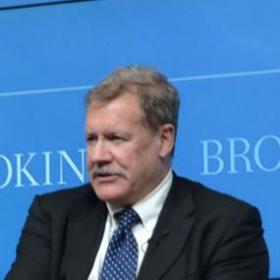
Austin Writes for New Europe on Failures of Diplomacy in Ukraine
There were clear warning signs to the Ukraine crisis, says EWI's Professorial Fellow Greg Austin. "If we want to get that future plan right, we do need to have some understanding of what went wrong."
Perhaps the current situation of Ukraine was inevitable in some way, given the emerging realities through the last several years. Inevitable or not, it was certainly foreseen.
In 2009, a group of eminent persons convened by the EastWest Institute warned of a possible crisis in and around Ukraine. The report documented a collapse of trust between NATO and the West, especially after the short military conflict in Georgia in 2008, and the failure of Europe’s institutions to address the basic challenges that surfaced in that unhappy event. “NATO and Russia have declared that they are no longer enemies”, the report noted. “They need to agree just what that means in terms of a number of important military/political issues.” It went on to say that the “heated debates over NATO expansion … provide the proof that the two sides have not yet made that fundamental settlement.”
It was absence of a fundamental settlement that prevented collaboration between Russia, Europe and the United States to help Ukraine through its crisis in the last five years and, more recently, since November last year.
The 2009 report warned that “If not corrected, those trends will produce negative strategic consequences for the future stability of Europe as a whole. This may be playing out in Ukraine, which is experiencing high levels of internal political tension at a time of a profound economic crisis.” And so it came to pass.
The report, titled EuroAtlantic Security: One Vision, Three Paths made several recommendations. Some are still relevant today, albeit with some adjustment. One set of recommendations (one of the three paths) that argued for a fundamental transformation of security relations, had warned that “there will be no reversal of the deteriorating trends in security relationships unless political leaders find a way to move decisively toward the joint decision-making and joint problem-solving in this sphere that are foreshadowed in the NATO-Russia Founding Act.” To address this, some members of the group recommended a mechanism to escape the unstable and narrowly conceived structure represented by the NATO Russia Council (NRC). One proposal was to create a new structure at EuroAtlantic level that would bring the heads of state of Russia, the EU and the United States together to create the necessary political channel which was missing in the NRC. This idea also had the advantage of modernising the Europe/Russia security relationship through a structure not dependent on NATO, Moscow’s historic adversary. Russians often complained that the NRC was really a “28 against 1” structure in which its voice was not taken seriously.
Given events in Ukraine so far in 2014, it is hard to imagine that the relationship between NATO and Russia will stabilise any time soon. Also, it may seem to many observers that the time is simply not right to think about the bigger picture while the very future of Ukraine is in peril. Yet we do need to look ahead to begin to imagine what a new, predictable and trusting security relationship between Russia and the rest of Europe will look like.
If we want to get that future plan right, we do need to have some understanding of what went wrong. Why was this crisis not avoided? One answer to this is that powerful NATO leaders wanted Ukraine to have the right to join it, while Russia was opposed to that right—the two views were irreconcilable and thus a security crisis in and over Ukraine was inevitable. Another answer, more serious in its implications, is that the diplomats on both sides failed to heed the clear warning signs, visible at least five years out, and failed to take appropriate preventive measures.
Photo credit: Sasha Maksymenko

